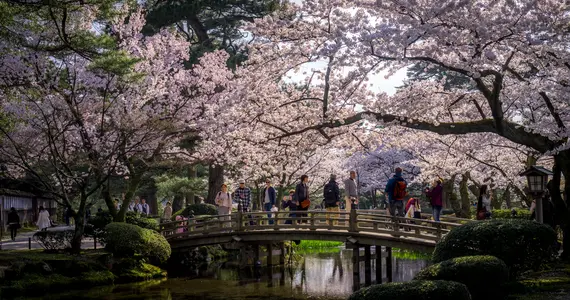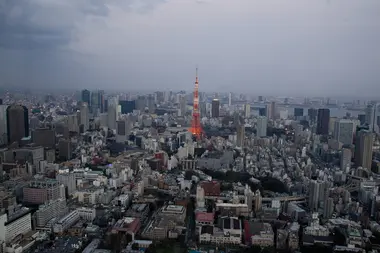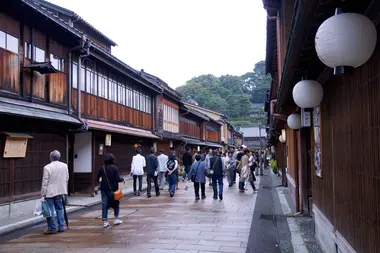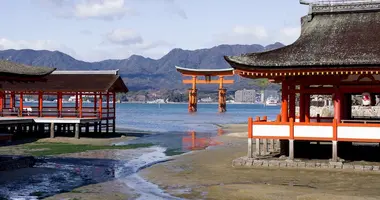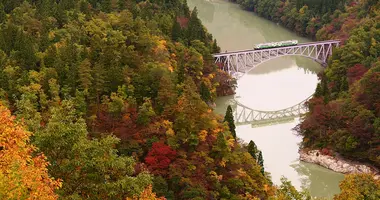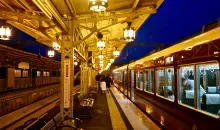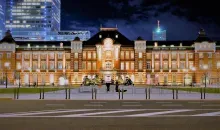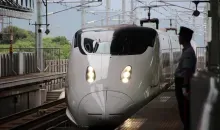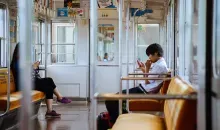How to get from Tokyo to Kanazawa
Going from Tokyo to Kanazawa entails crossing the center of Honshu Island out to the Japan Sea Coast. Kanazawa, the capital of Ishikawa Prefecture and the largest city in the Hokuriku Region, is the current terminus of the Hokuriku Shinkansen.
How to get from Tokyo to Kanazawa via Shinkansen bullet train
Kanazawa Station
How to get from Tokyo to Kanazawa with the Shinkansen bullet train
Via the Hokuriku Shinkansen, travelers from Tokyo can board the bullet train at either Tokyo Station or Ueno Station and then arrive directly at Kanazawa Station in about 2.5 to 3 hours, covering around 470 kilometers (292 miles). Individual Shinkansen tickets start at 14,180 yen without reserved seats, with the option to make a seat reservation at a slight surcharge. Additionally, the trip is fully rideable with the JR Pass. The first Shinkansen train out to Kanazawa from Tokyo leaves at 6:16 AM, and the last departure is at 9:04 PM.
Hokuriku Shinkansen bullet trains available on this itinerary:
| Hakutaka Shinkansen Bullet Train | Kagayaki Shinkansen Bullet Train |
Reserve Shinkansen tickets from Tokyo to Kanazawa!
Reserving seats on the Shinkansen
Individual ticket holders and holders of a JR Pass are able to book seats on Shinkansen bullet trains in advance of boarding. Shinkansen usually offers non-reserved cars with seats available on a first-come, first-served basis; therefore, reservations are not usually necessary. Usually, these are the vehicle numbers 1-4.
There are Shinkansen bullet trains that consist of all reservation-only cars, so be aware of this. All travelers are advised, therefore, to attempt to purchase their tickets during the peak travel periods in Japan, which are the spring and the New Year's vacation. A reserved seat requires additional payment when purchasing a single ticket, although JR Pass subscribers are exempt from this fee.
Oversized baggage on the Shinkansen
Passengers with big bags need to meet a number of restrictions in order to board the Shinkansen. Baggage over 160 cm in length, breadth, and height must be checked into the designated bulky baggage section located at the rear of the train car, per Japan Railway regulations. Additionally, owners of such bags need to reserve seats close to this area. Kindly note that bags larger than 250 cm in total are not allowed on the Shinkansen.
The baggage restrictions do not apply to baby carriages, musical instruments in cases, or athletic equipment (bikes, snowboards, etc.) in cases.
Exploring Tokyo
Often the initial destination for those traversing Japan’s “Golden Route,” the nation’s capital of Tokyo has something for everyone, on account of it being the world’s largest city in terms of population. From exploring the light-filled night streets of Shinjuku to the slower, hip neighborhoods like Koenji and Gakugei Daigaku, there is adventure to discover at practically every train station within this urban metropolis.
And speaking of these train stations, Tokyo’s well-developed and far-reaching train network is perfect for getting to where you need to go and made only easier for holders of the JR Pass. Using major stations such as Shinjuku, Shibuya, Tokyo, or Ikebukuro Stations as a central hub, much of the city is widely accessible via the many train lines, from the ones operated by JR to the Subway Metro System. It’s easy to choose a train station you may be unfamiliar with and take the opportunity to discover a new neighborhood. There are charming cafes, stylish shops, and a medley of other attractions to go out and see.
For traveling foodies, Tokyo is an essential destination, home to an endless array of quality restaurants, from unassuming local shops to world-famous establishments. Food options also come in the form of quick, easy, and affordable street food to luxurious and acclaimed high-end dining (and in fact, Tokyo is home to the most Michelin-starred establishments in the world). For the ultimate culinary experience, hip neighborhoods like Hatagaya and Setagaya are often visited for their lively sake and wine bars, and Higashi Azabu is home to a medley of acclaimed restaurants for the perfect night-time meal.
The Shinkansen train leaves for Kanazawa Station from Shinagawa Station or Tokyo Station, which are both on the JR Yamanote Line and located in the center of Tokyo. The area around Tokyo Station is mostly commercial, featuring luxury department shops, retail malls, fast food and fine dining options, as well as serene parks like Hibiya Park and Imperial Palace Park. The station is home to a huge network of additional shops, restaurants, and department stores.
Ueno Station is in the eastern sector of Tokyo with a number of interesting attractions around. Modest dining establishments line the streets around the station and the nearby Ueno Park and zoo are favorites of the city’s inhabitants. A great area to do some shopping is the Aki-Oka Artisan Alley nearby Akihabara, home to a number of small, independent shops with unique offerings.
Exploring Kanazawa
For many, Kanazawa is a place simply described as a city with a great appreciation for beauty. Kanazawa is the capital of Ishikawa Prefecture and sits modestly as the largest city in Hokuriku. It was largely untouched during World War II, allowing its historic districts and traditional crafts to be largely preserved to the present day. Perfectly walkable, the current terminus for the Hokuriku Shinkansen is one that is ideal for exploration and discovery.
The name Kanazawa itself means “golden marsh,” which is well represented in many of the city’s attractions. A city well-regarded for its artistry, many crafts from this region utilize gold details, and a medley of different workshops and galleries can be found throughout the city to see them. Additionally, those with a sweet tooth will adore the gold leaf-adorned soft-service ice cream that can be found at dessert spots throughout.
Kanazawa is also home to Kenroku-en, one of Japan’s three great gardens. The garden was initially opened to the public in the late 1800s and hosts special night-time illumination events in spring for the cherry blossoms and changing leaves during autumn. It is nearby the illustrious Kanazawa Castle and 21st Century Contemporary Art Museum, making this central location a hub for fun and activities. To further delve into Kanazawa's rich history, Higashi-chaya is an essential destination. This is a traditional tea district that has maintained many of its original structures for centuries and is an ideal spot for taking pictures. Many visitors to Kanazawa from both abroad and from other parts of Japan walk around this area while wearing traditional yukata. Within the district are, of course, traditional tea houses, shops selling small gifts and crafts, and cafes and restaurants. Head to the top of the hill overlooking Higashi-chaya to see Yamano-o, a traditional Japanese ryokan and kaiseki restaurant operated by the same family for five generations.
In terms of cuisine, Kanazawa is a premier destination, with the seafood from Toyama Bay and the Japan Sea being at the forefront. Omicho Market, a short walk from Kanazawa Station, is often cited as the “kitchen of Kanazawa,” and visitors can tour around the different stalls and try the prefecture’s fresh delicacies. There are also a number of great restaurants inside the market to visit for a nice meal. Ishikawa is famous for nodoguro, known as Black Throat Seaperch in English. It’s a local delicacy noted for its rich white meat and fattiness during the winter and is a signature item at many restaurants within the city.
Additionally, Kanazawa has easy access to major cities in Kansai, such as Osaka and Kyoto, via the Thunderbird Train (though the Thunderbird will be phased out once the Hokuriku Shinkansen extends past Kanazawa in 2024). To many, Kanazawa is cited as a "Mini Kyoto" due to its traditional atmosphere and numerous shrines, temples, and historical sites. It sees less crowds than Kyoto during peak seasons, making it a great alternative to the ancient capital of Japan, though both are worthwhile destinations for your trip.
Kanazawa Station is the last stop on the Hokuriku Shinkansen that crosses Honshu Island from Tokyo out to the Japan Sea Coast. From Tokyo, passengers can ride the Shinkansen bullet train from either Tokyo Station or Ueno Station. Kanazawa Station itself is famous for the large gate-like structure in the front, known as the Tsuzumimon Gate. This structure is meant to resemble both a Shinto torii gate and traditional Japanese drums known as tsuzumi. This gate has become a symbol of Kanazawa itself, and to many, from a distance, the site of the gate with the dome of the station itself resembles a samurai helmet.
Honshu from coast to coast
Despite being the largest city in Hokuriku, Kanazawa in Ishikawa Prefecture is almost like a separate world compared to the densely-populated, sprawling urbanscape of Tokyo, and it's perhaps because of this distinct difference that both locations are well worth the trip out. Kanazawa, very tranquil and perfectly walkable, can be seen as the Japan of fantasy films and can be accessed with a direct trip via the Hokuriku Shinkansen bullet train. Be sure to book your ticket from Tokyo to Hokuriku with or without a reserved seat, or opt for a JR Pass for unlimited train access throughout Japan!

